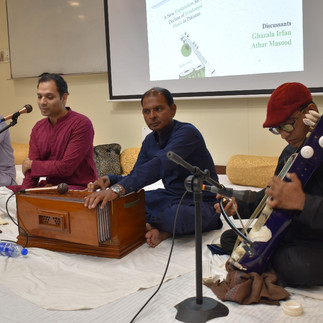A New Explanation for the Decline of Hindustani Music in Pakistan
- asadullah3
- Apr 18
- 2 min read
Friday, April 11, 2025 | 6:30 - 8:30 PM | SS Auditorium, Academic Block, LUMS

The Gurmani Centre for Languages and Literature at LUMS hosted a session featuring Kabir Altaf, author of A New Explanation for the Decline of Hindustani Music in Pakistan. The event brought together a diverse audience of students, scholars, artists, and music enthusiasts, and featured a book talk, critical responses by Dr. Ghazala Irfan and Athar Masood, and a moving musical performance by the author himself.
Kabir Altaf’s book, originally submitted as a dissertation for an M.Mus. in Ethnomusicology at SOAS, offers a sharp and refreshingly original intervention in the ongoing discourse on the decline of Hindustani classical music in Pakistan. He departs from conventional explanations centered on religion, nationalism, and loss of patronage, and instead situates the decline within broader sociological processes, most notably the asymmetric cultural impact of Partition, modernization in the 1960s, and the restructuring of gharana family systems.
In tracing how key musical traditions were disrupted, Altaf points out that while Partition affected relatively small geographic areas (Punjab and Bengal), these were precisely the regions where classical music flourished in what became Pakistan. Unlike India, where official patronage and media platforms supported classical music’s survival, Pakistan’s evolving musical economy and sociopolitical changes contributed to its erosion.
Respondent Dr. Ghazala Irfan offered a constructive critique, drawing on archival documents from APMC and her ethnographic insights. She challenged the idea of a quantitative decline, noting that gharanedar musicians continue to perform, and venues such as the Open-Air Theatre in Lahore regularly attract large, appreciative audiences.
Altaf responded by clarifying his focus: the khayal tradition—a more ancient, complex form of Hindustani music—has indeed suffered significant erosion in both visibility and depth. This productive exchange grounded the debate in both lived musical practices and archival research, modeling how academic disagreement can expand, rather than constrain, understanding.
Athar Masood praised the book as a rare example of scholarly writing that successfully blends academic rigor with practical musical insight. He highlighted the author’s formal training in classical music and commended the nuanced critique of “adaptive strategies,” such as fusion bands and commercial platforms like Coke Studio. While acknowledging that these platforms provide visibility and income, Altaf notes their limitations: performances often abandon traditional aesthetics, turning classical motifs into pop concert experiences. As Athar Masood rightly summarized, Coke Studio has provided a lifeline—but not necessarily a revival.
The evening concluded with a live performance by Kabir Altaf, where music itself became a mode of pedagogy. He performed khayāl, dardā, and ghazal, carefully distinguishing their tonal and emotional registers. Not only did he elucidate the distinct structure and mood of each form, but he also wove a mellifluous atmosphere that resonated deeply, drawing the audience into a shared moment of lyrical contemplation. The performance stood as a living testament to the depth and adaptability of classical music, even in a time of perceived decline.
Kabir Altaf’s work is more than a critique of decline—it is a call to reimagine cultural continuity through a sociological, historical, and musical lens.















